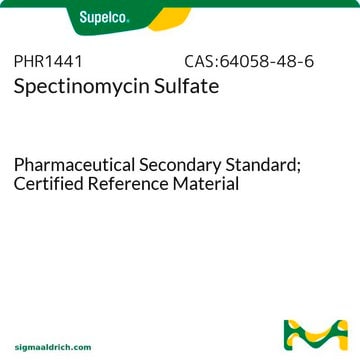85555
Spectinomycin dihydrochloride pentahydrate
≥98.0% (AT)
About This Item
Recommended Products
biological source
synthetic
Assay
≥98.0% (AT)
form
solid
color
white
solubility
H2O: 50 mg/mL, clear, faintly yellow
antibiotic activity spectrum
Gram-negative bacteria
Gram-positive bacteria
Mode of action
protein synthesis | interferes
storage temp.
2-8°C
SMILES string
Cl[H].Cl[H].[H]O[H].[H]O[H].[H]O[H].[H]O[H].[H]O[H].[H][C@@]12O[C@H](C)CC(=O)[C@]1(O)O[C@]3([H])[C@@H](NC)[C@@H](O)[C@@H](NC)[C@H](O)[C@@]3([H])O2
InChI
1S/C14H24N2O7.2ClH.5H2O/c1-5-4-6(17)14(20)13(21-5)22-12-10(19)7(15-2)9(18)8(16-3)11(12)23-14;;;;;;;/h5,7-13,15-16,18-20H,4H2,1-3H3;2*1H;5*1H2/t5-,7-,8+,9+,10+,11-,12-,13+,14+;;;;;;;/m1......./s1
InChI key
DCHJOVNPPSBWHK-UXXUFHFZSA-N
Looking for similar products? Visit Product Comparison Guide
General description
Application
Caution
Preparation Note
Other Notes
Signal Word
Warning
Hazard Statements
Precautionary Statements
Hazard Classifications
Eye Irrit. 2 - Skin Irrit. 2 - STOT SE 3
Target Organs
Respiratory system
Storage Class Code
11 - Combustible Solids
WGK
WGK 2
Flash Point(F)
Not applicable
Flash Point(C)
Not applicable
Personal Protective Equipment
Certificates of Analysis (COA)
Search for Certificates of Analysis (COA) by entering the products Lot/Batch Number. Lot and Batch Numbers can be found on a product’s label following the words ‘Lot’ or ‘Batch’.
Already Own This Product?
Find documentation for the products that you have recently purchased in the Document Library.
Customers Also Viewed
Our team of scientists has experience in all areas of research including Life Science, Material Science, Chemical Synthesis, Chromatography, Analytical and many others.
Contact Technical Service







